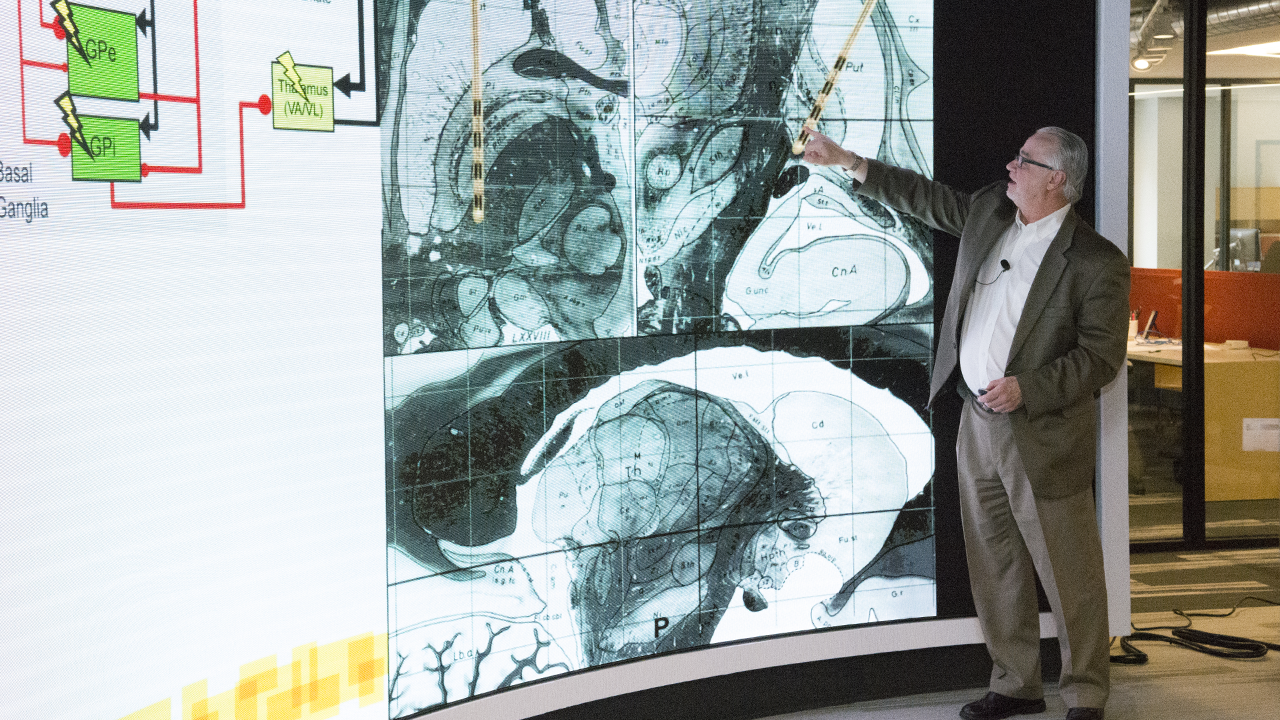
U of M neurologist Jerrold Vitek, MD, Ph.D., presents on the state of neuromodulation technologies as part of the Neuroscience Technology Showcase.
From treating sleep problems in patients with Parkinson’s to recording neural activity to improve robotic limbs, researchers at the University of Minnesota are finding new and improved ways to tackle debilitating, brain-related health problems.
On Tuesday, industry experts and investors gathered to learn about promising technologies at the U that aim to help patients with a wide variety of neurological disorders. The Neuroscience Technology Showcase, hosted by the U’s Office for Technology Commercialization in partnership with Silicon Valley Bank, highlighted technologies that hold the potential to more effectively treat neurological disorders ranging from dystonia to depression with fewer side effects and longer-lasting benefits than existing treatments.
What the technologies had in common was their use of a method called “neuromodulation”—where scientists adjust the activity of certain neural circuits to decrease symptoms and improve brain function. Neuromodulation comes in several forms, such as stimulating the brain using implanted electrodes or targeting brain regions from outside of the head using high-frequency sound waves. Research into these approaches has been accelerated over the past five years through the state-funded MnDRIVE Brain Conditions research initiative.
Jerrold Vitek, MD, Ph.D., head of the U of M Medical School’s Department of Neurology and director of the Udall Center of Excellence for Parkinson’s Disease Research, said many investors are tempted to wait for new technology to develop before financially supporting it.
“The bottom line is we can’t wait—there are patients out there that need the technology,” Vitek said. “I want to be on the front line of these technologies. When I take care of a patient, I want the best outcome I can get.”
Researchers are working on many ways to improve neuromodulation methods, he added. For example, one challenge is developing better imaging methods to help scientists more precisely hone in their treatments to specific areas of the brain, avoiding the side effects that result from stimulating other areas nearby. Another challenge is advancing the programming of neuromodulation devices so they can better monitor and adjust stimulation to fit a patient’s treatment needs as they change throughout the day.
The key to getting these solutions beyond the lab, through the regulatory process, and into the hands of doctors is private investment and industry partnership, said Jay Schrankler, the U’s associate vice president of technology commercialization and new ventures.
“In order for new technologies to make a real impact in society, we need to bring them into the marketplace,” Schrankler said. “We are excited to form new connections to advance these technologies. We believe today’s partnerships will ultimately lead to better treatment outcomes down the road.”
Neuroscience technologies are near the top of the most active medical device investing areas, according to a report from Silicon Valley Bank. From 2016 to 2017, financing in neuro devices increased by over 40 percent and invested equity grew by over 50 percent. These technologies also rank third highest in “series A” investing (the first round of venture capital investment).
A Convergence of Medical Device Leaders
The Neuroscience Technology Showcase took place alongside a major U of M-hosted conference that focused more broadly across the different types of medical devices. Over 1,300 attendees came to the Twin Cities campus from April 9–12 for the 17th annual Design of Medical Devices Conference.
The international conference is the largest of its kind in the world, bringing together leaders from industry and academia to address emerging trends and opportunities in medical device design, digital health, policy, engineering, education, and commercialization.